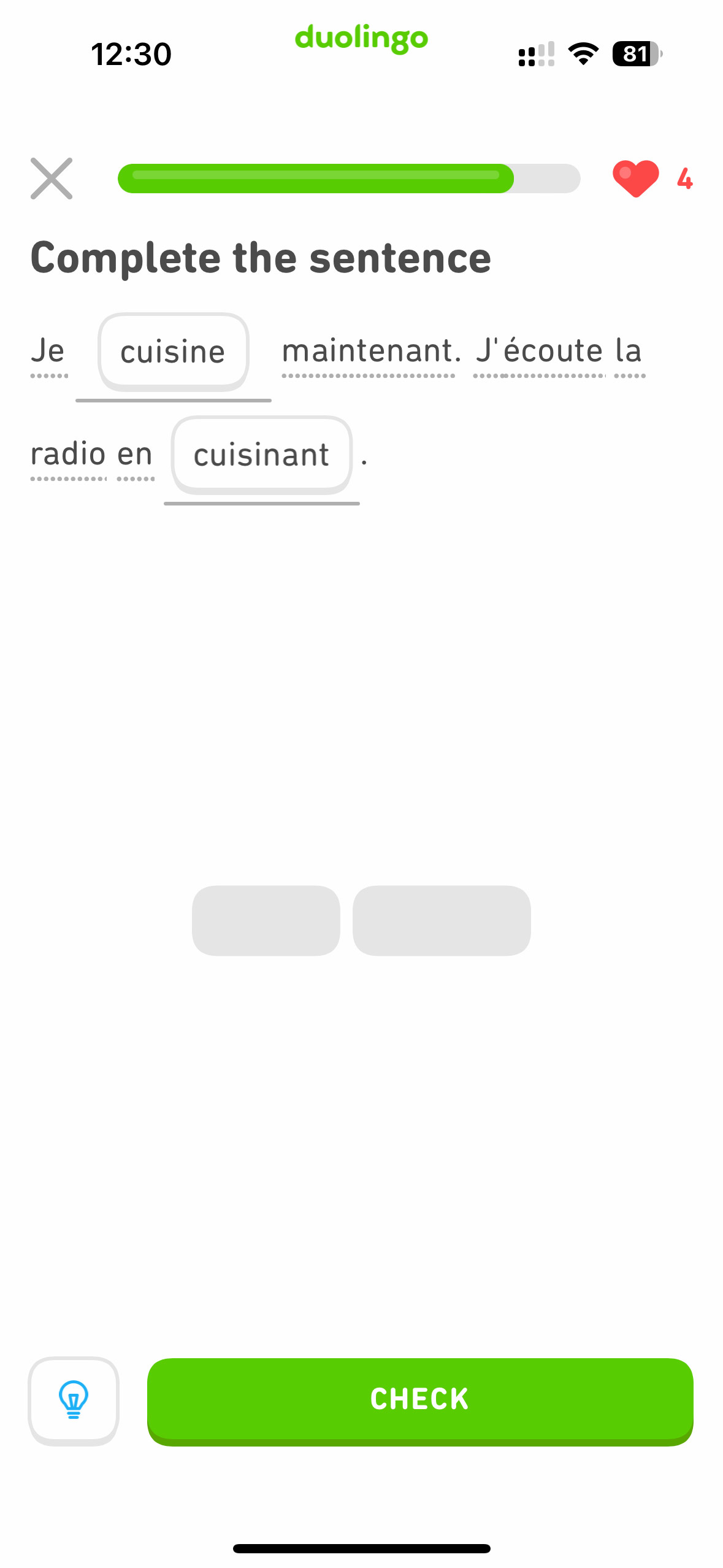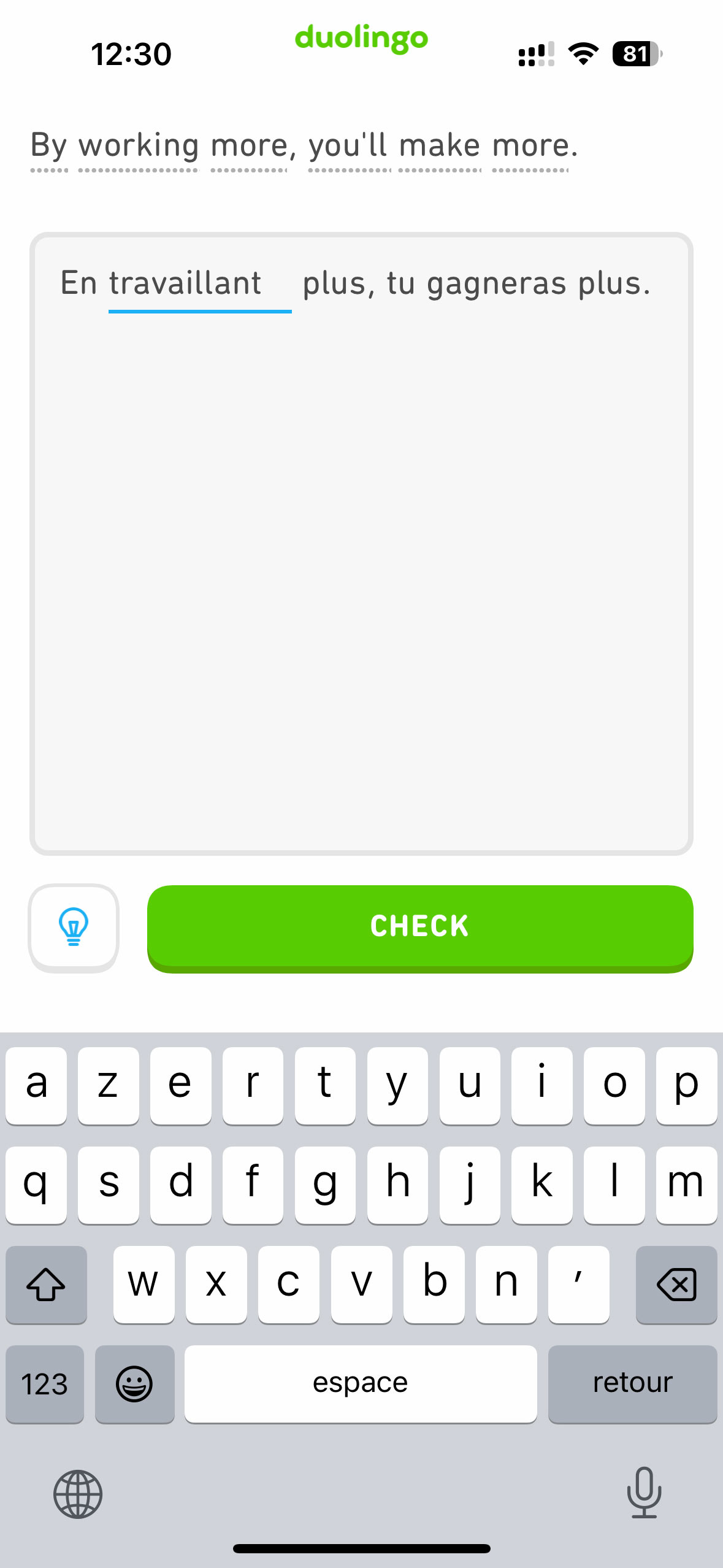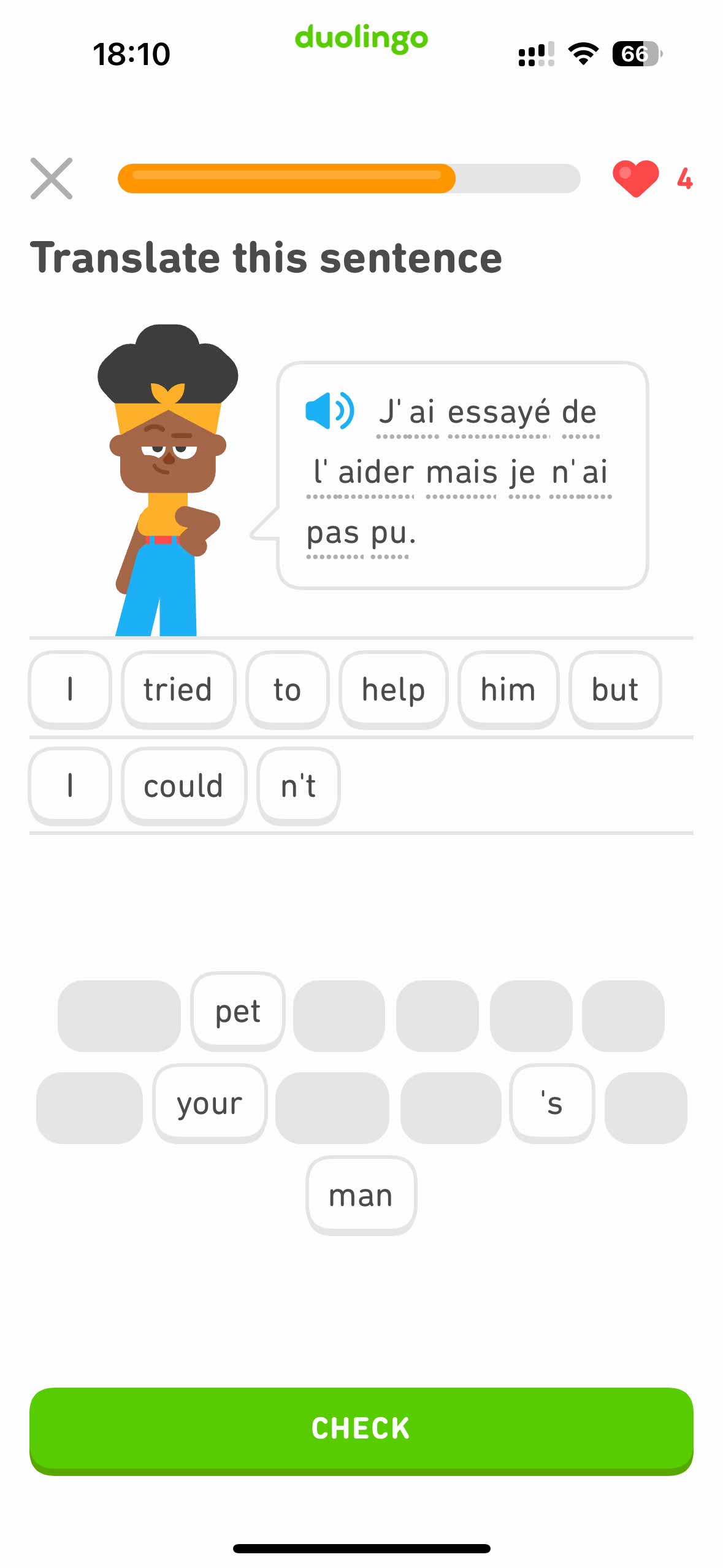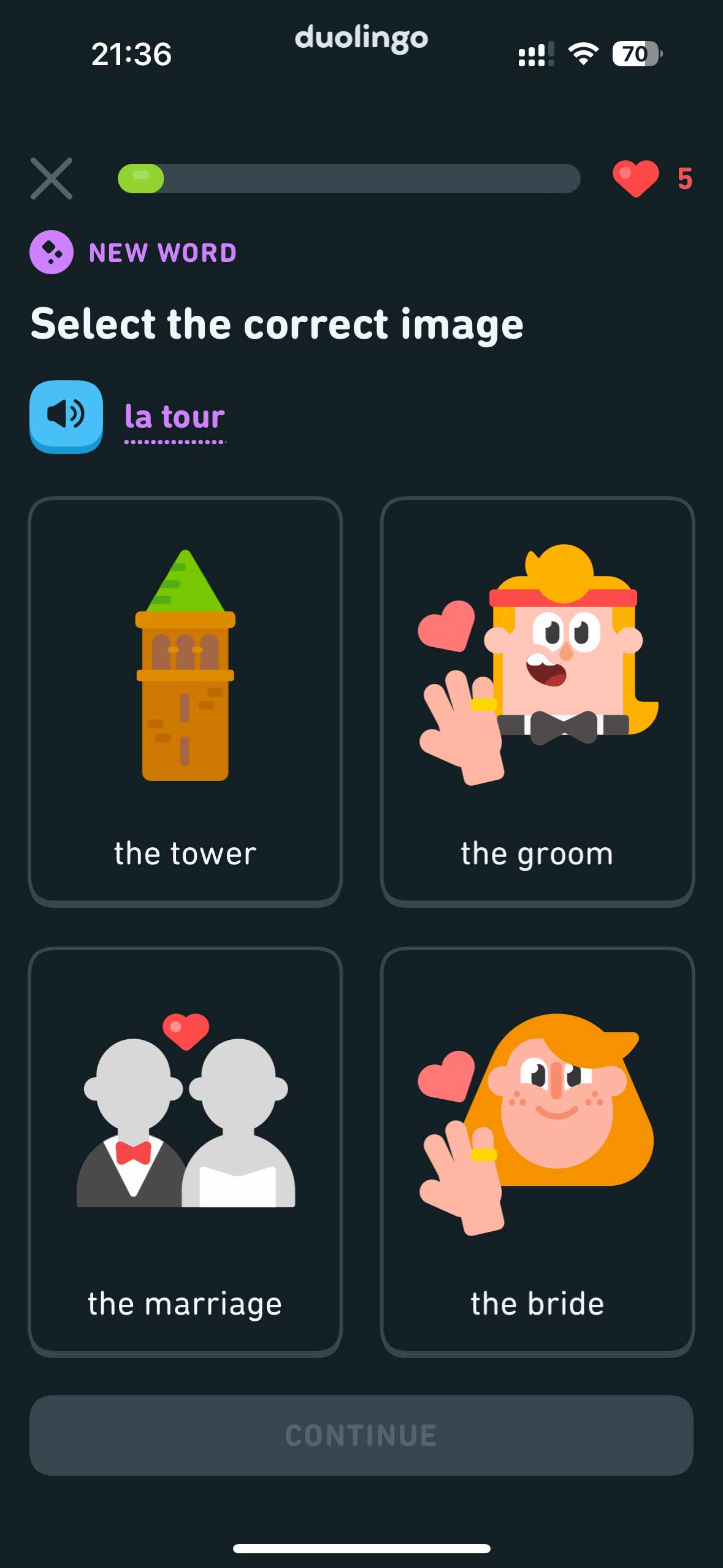Duolingo Review
As one of the most popular language-learning apps, Duolingo has garnered a substantial following. But how effective is it, really? Join me as we delve into the inner workings of Duolingo, examining its features, accessibility, and learning experience across platforms. Gain a clearer understanding of what this language-learning tool has to offer and whether it’s the right fit for your linguistic journey.
Introduction
Duolingo is a popular and widely-used language learning platform designed to make learning a new language accessible and engaging for users of all ages and backgrounds. Launched in 2011, the platform offers a variety of language courses, including commonly spoken languages like Spanish, French, and German, as well as lesser-known languages such as Zulu, Scottish Gaelic and Esperanto and even constructed languages such as Klingon (Star Trek) and High Valrian (Game of Thrones). For English speakers, there are 39 languages (including constructed languages) plus Xhosa which is currently in development.
Duolingo employs a gamified approach to language learning, incorporating features like experience points, streaks, and leaderboards to motivate users to practice daily. The platform combines various learning tools, including lessons, and practice exercises. Duolingo is available on both desktop and mobile devices and offers a free version with optional premium features through two subscription plans called Super Duolingo and Duolingo Max.
Now the last time I tried Duolingo was back in 2017 when I started learning French and I used it and completed the French tree. However, a lot has changed, been removed, new things added and most recently in August 2022, Duolingo completely overhauled its design to a more linear change. So far, I’ve found the app much more pleasant to use, the UI is pleasant on the eyes, and the French course’s audio has improved since last time.
Duolingo also seems to have the habit of removing features without warning; whilst I’m not sorry to see some of the features go (i.e. conversation bots). But when features that many people find useful like downloading lessons offline, community answers are removed and old trophies then I can understand that some users get a bit frustrated about the lack of transparency and communication about changes from the company.
Courses
As I mentioned above, there is a huge range of languages to huge from. Each course differs in length, the two biggest being Spanish and French for English speakers. Some of the more minor languages only have a fraction of the number of lessons. Here are the courses available for English speakers:
“Asian” languages: Chinese, Japanese, Korean, Indonesian, Vietnamese and Hindi.
Bantu languages: Swahili, Xhosa (in development) and Zulu.
Celtic languages: Irish, Scottish Gaelic and Welsh.
Constructed languages: Esperanto, High Valyrian and Klingon.
“Dead” languages: Latin.
Germanic languages: Danish, Dutch, German, Norwegian, Swedish and Yiddish.
Romance languages: French, Haitian Creole, Italian, Romanian, Portuguese and Spanish.
Slavic languages: Czech, Polish, Ukrainian and Russian.
Uralic languages: Hungarian and Finnish.
Other languages: Hawaiian, Navajo, Arabic, Turkish, Greek and Hebrew.
Gamification and Learning Incentives
Duolingo’s gamification is what in part has made it so popular. By incorporating engaging features like XP points, badges, and rewards (gems), the platform creates an enjoyable learning experience that maintains user interest and encourages consistent practice. The app cleverly utilises streaks and leaderboards to foster a sense of friendly competition, while virtual currency and badges incentivise users to reach their language goals. Duolingo’s interactive lessons are concise and well-structured, ensuring users remain engaged without feeling too overwhelmed. This gamified approach has made language learning more accessible and appealing to the broader language-learning audience.
My favourite aspect of Duolingo is its competitive nature. As someone who thrives on competition, the platform’s ability to pit users against each other while learning effectively maintains my motivation. However, as a free user, it can be challenging to keep up with premium users who have access to unlimited hearts.
Duolingo also emphasizes the importance of regular practice by:
-
- Streaks: Tracking the number of consecutive days users practice, thus encouraging consistency and commitment to learning.
- Leaderboards and Leagues: Grouping users into leagues based on their weekly XP to foster friendly competition and motivation for regular practice (this aspect appeals to me the most as a competitive person).
- Daily Notifications: Sending reminders (provided the user enables notifications) to complete daily goals, promoting consistent engagement with the platform.
Reading, Writing and Listening
This is the bread and butter of Duolingo, you will spend the majority of your time either reading, listening and then translating. Since Duolingo’s learning approach is primarily translation-based. This might involve you filling in a blank, completing a dialogue, or showing that you understand a text by giving the correct response. Some of these are harder than others. Over a period of time, it does get repetitive, but again, Duolingo isn’t something you should be spending your whole day on, more like short moments of free time.
Speaking
Duolingo does allow the user to practice their speaking but in my opinion, it has some limitations when it comes to improving speaking skills: Firstly, you get very limited speaking practice with Duolingo’s speaking exercises that mostly involve repeating phrases or sentences. This doesn’t provide enough opportunities to practice spontaneous conversation or develop the ability to respond to unpredictable situations.
Secondly, there isn’t any real-time feedback: Duolingo relies on automated speech recognition for its speaking exercises, which doesn’t provide the same level of feedback as interacting with a native speaker or a language teacher. This means you may not receive immediate correction on pronunciation or intonation errors. I tried doing the speaking exercises with an awful accent, mispronouncing words, and even not saying some words and it still passed me.
Learning Experience
Duolingo utilises a combination of teaching methods to help users develop their vocabulary, grammar, reading, listening, and writing skills but still your traditional course-based type of app. The platform offers a series of skill-based lessons, often starting with basic vocabulary and gradually progressing to more complex grammar structures. The lessons are interactive, with users completing exercises that involve translation, matching words with their meanings, speaking and listening to audio recordings. This diverse approach helps maintain user engagement and caters to different learning styles.
Overall, I’ve found a lot of the exercises unchanged, some removed and some new ones. Check out the images below to see the different types of exercises Duolingo likes to throw at you.
The above images, show some typical lessons you can expect to see, from left to right, a complete the sentence exercise, with only two options, a story exercise, where you listen to a conversation and occasionally answer questions, a fill-in-the-blank type exercise and lastly a speaking exercise.
From left to right, a listening exercise where you have to select the correct word between two words that typically sound alike. Following that, a straightforward ‘translate this sentence’ task, then, another listening exercise where you simply have to type the sentence you hear. And finally, a select the correct image exercise, which is pretty straightforward.
Effectiveness and Results
Duolingo is an effective language learning platform that has garnered widespread acclaim for its gamified approach and accessibility. Its engaging interface and comprehensive range of languages make it an appealing option for users with beginner/intermediate knowledge of their target language. While Duolingo may not necessarily replace traditional language courses that have more depth or native language immersion. The gamified approach with leagues and competition with other users motivates many people to continue learning (I’m one of them). I’ve also found it incredibly useful for brushing up on my conjugations.
The effectiveness of Duolingo depends on your commitment and consistency in using the app, as well as using supplementary resources for a more holistic language learning experience. Overall, Duolingo serves as a valuable tool in the language learning arsenal, fostering motivation and progress for many users. Many people, myself included had negative views of Duolingo, but after coming back to it after this review I can see the purpose it serves. When I want to study or be immersed in French, then using Duolingo would obviously be an inefficient use of my time, however, Duolingo isn’t out to replace conventional learning approaches or courses, Duolingo’s aim seems to be competing for your attention during deadtime e.g. when you’re sitting on the couch scrolling away on your phone or on the bus commuting to work. So, if we look at Duolingo for what it ultimately is, then I think it’s a great way to kill some time and brush up on vocab, and conjugations, that would be otherwise lost to endless scrolling on social media.
Over the past, Duolingo has attracted some criticism for its really bizarre sentence choice, apparently, this is by design in order to facilitate learning and help you to remember. They wrote an interesting blog post about it .
Desktop vs Mobile
I have tried Duolingo on both desktop and iOS and it’s very clear which team gets the majority of the budget. I personally prefer to use the computer to learn because I spend a large portion of the day behind one, and I’m the type of person to leave my phone unattended for hours. But, unfortunately, the desktop version feels like it’s lacking compared to the mobile version. Now obviously they probably make most of their money from mobile users so it makes sense from a business perspective, but on the other hand, it’s a shame because even small quality-of-life features such as changing the text bubble positions with your cursor don’t work on desktop.
Inconsistencies
Another notable difference between the platforms is the heart system on mobile, which like in a video game, you lose hearts when you get answers wrong, you have 5 total. Free users have three options to restore hearts, the first is to wait, a heart takes five hours to refill, so all up, five will take 25 hours. The Second way is to use gems to refill your hearts. And lastly, you can complete a practice, followed by watching a 30-second ad in order to earn a heart. This system is absent from the desktop version, which provides an alternative for users who have depleted their hearts on mobile. Duolingo has stated that there are no plans to implement this feature on the web version.
Another inconsistency between the desktop and mobile versions of Duolingo lies in the currency system and course organisation. On the desktop platform, users earn lingots (red gems), while on the mobile app, they accumulate gems (blue gems). The reason for this difference is unclear, but it can be confusing for users who switch between platforms.
Additionally, the layout of the courses varies between the two versions. On the web, course progress is presented as a series of lessons, such as Lesson 110 in the French course, while on mobile, it is displayed in a section-unit format, like Section 5: Unit 33. Although the choice of layout may not be significant for some people, for some like myself it can be quite jarring. Having a consistent design across both desktop and mobile platforms would undoubtedly enhance the user experience by ensuring seamless transitions and uniformity.
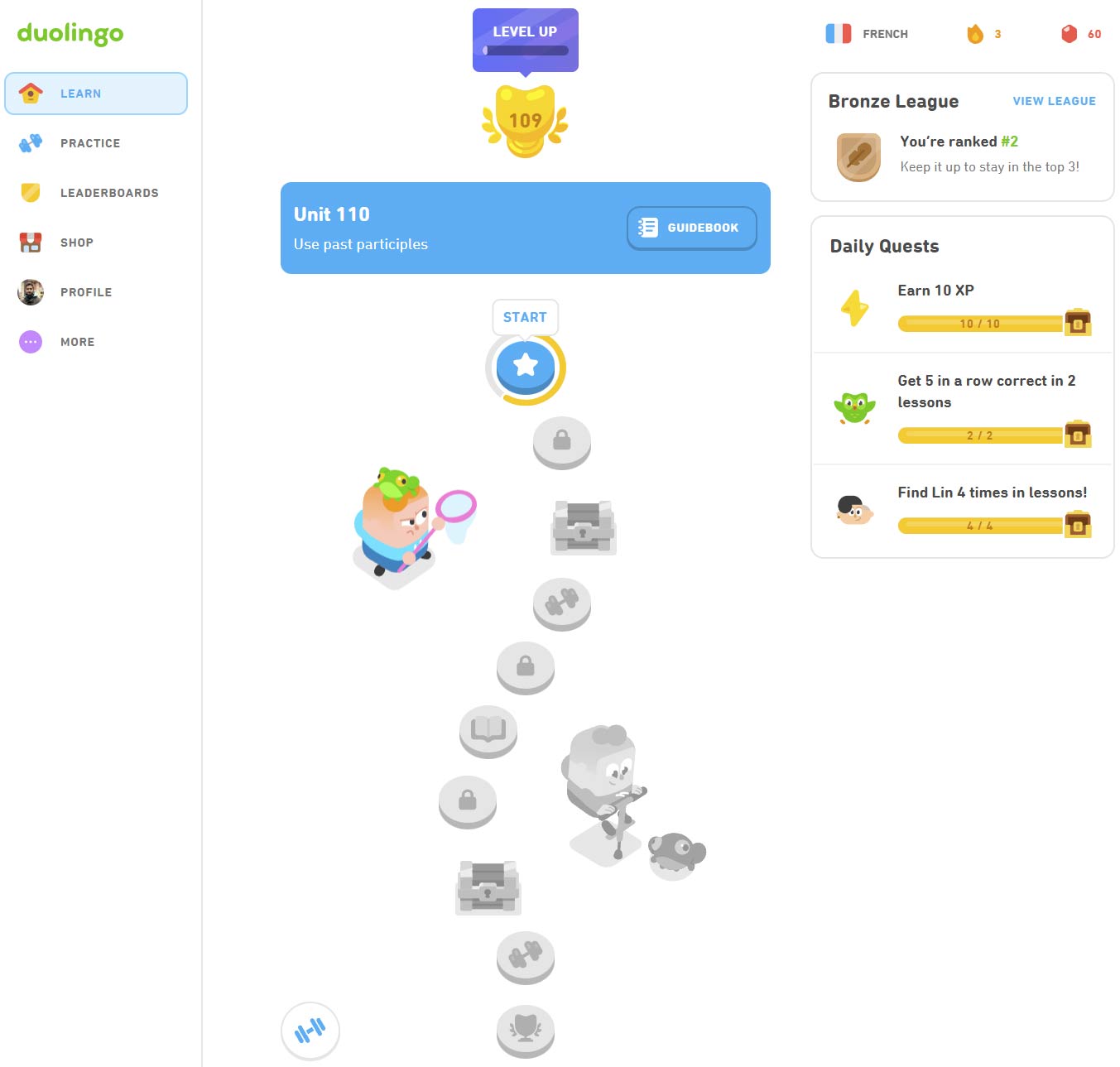
An example of Duolingo on a desktop.
Podcast
I would like to highlight the Duolingo podcast, which is tailored for a variety of language learners, including Spanish and French for English speakers, as well as English for Spanish and Portuguese speakers. These engaging podcasts can be found on platforms such as Apple Podcasts, Google Podcasts, and Spotify, and they come with the added benefit of accompanying transcripts.
Each episode runs for approximately 20 minutes and covers a range of interesting topics, making them an excellent resource for beginners seeking accessible, entry-level content. Furthermore, the podcasts are entirely free, adding to their appeal.
While the podcasts do provide translations and explanations, some might prefer a fully immersive experience in the target language. However, it is important to remember that these podcasts are primarily designed for novice language learners, striking a balance between accessibility and exposure to the target language.
Pricing and Premium Features
The best thing about Duolingo is that it’s free, it doesn’t feel like some freemium apps where they make it super difficult to progress without purchasing a subscription, well at least with Duolingo that isn’t the case. The free version grants access to all language courses and the majority of its learning tools. However, the free version is ad-supported, meaning at the end of lessons and challenges you will get ad popups, which I’ll admit can get tiresome after a while, you also won’t have access to certain features that are locked behind a paywall, especially in the review section where you revise your previous mistakes. You can still participate in legendary challenges, but as a free-user you will have to use your gems in order to take part.
Currently, Duolingo has two tiers of premium service and if you want access to the additional premium features you will need to purchase a premium subscription for ‘Super Duolingo’ which was previously known as ‘Duolingo Plus’ and the newest tier and most expensive called ‘Duolingo Max’ which gives you all the features of Super Duolingo plus two additional features: Explain my answer and Roleplay with AI (think Duolingo + ChatGPT), both of these new features are as of the date of writing only available on iOS in the French and Spanish courses for English speakers.
How much?
When you create an account on Duolingo, you will be given the option to choose between a 7-day trial for the monthly payment plan or a two-week trial for the 12-month payment plan. This trial period can be activated at any point in time and provides an excellent opportunity to evaluate whether the additional functionality is necessary for you.
If you’re a fan of Duolingo and wish to either support the company or gain access to its premium features, then you have the option to pay for a subscription. The cost varies based on your selection of either Max or Super, as well as whether you choose a yearly or monthly payment plan.
I personally wouldn’t pay for Super or Max, only maybe one day if the ads drive me mad, but for the moment I don’t spend much time every day on Duolingo so I can put up with a couple of ads and I never run out of hearts, but I can imagine it becoming frustrating having to recharge hearts frequently as a free user. If you’re thinking of upgrading and it’s nearing Christmas, it might be worth holding off as Duolingo typically have an end-of-year sale where you can get it much cheaper.
| Super Duolingo | Duolingo Max |
|---|---|
| 1 month: $12.99 USD | 1 month: $30 USD |
| 12 months: $83.99 USD | 12 months: $168 USD |
| 12-month Family Plan: $119.99 USD | 12-month Family plan: $209 USD |
| Super Duolingo | Duolingo Max |
|---|---|
| 1 month: $12.99 | 1 month: $30 |
| 12 months: $83.99 | 12 months: $168 |
| 12-month Family Plan: $119.99 | 12-month Family plan: $209 |
Prices are in USD and are changed every now and then and also differ from region to region: click the link below to find out the price in your region.
Conclusion
In conclusion, Duolingo has proven its popularity over the years as a valuable language-learning platform for many people, offering an engaging and accessible experience to users of all levels. Its gamified approach, wide selection of languages, and variety of learning tools make it an appealing option for beginners and intermediate learners. However, it’s essential to supplement Duolingo with additional resources to ensure a more comprehensive learning experience.
While the platform has its limitations, particularly in terms of speaking practice, it’s undoubtedly an effective way to build vocabulary and enhance reading, and listening skills. The experience varies between desktop and mobile versions, with the latter receiving more attention and updates, but both platforms can be used effectively. With a range of pricing options, including a free version, Duolingo offers a cost-effective solution for language learning. Ultimately, I’ve changed my tune and I would recommend it if you’re just starting out in a language, it’s a great tool that you can do on the side when you’re bored or have some dead time on the couch. But I wouldn’t recommend it as a tool if you’re going to spend hours on it each day, it’d be more efficient to spend your time elsewhere.
You can check our other reviews here.
| Duolingo |
Price: free |
|---|---|
THE GOOD
|
THE BAD
|
SUMMARY
In summary, Duolingo is a popular and engaging language-learning platform ideal for beginners and intermediate learners, but it requires supplementary resources for a comprehensive learning experience. While I don’t recommend it for extensive daily use, it serves as a cost-effective and convenient tool for casual language practice.
| Duolingo |
|---|
THE GOOD
|
|
THE BAD
|
SUMMARY
italki is hands down the best tool available if in-person interaction is not an option. It offers the most convenient booking system and has the largest database of available teachers. Teachers range in quality however.
Feel free to check out my old review of Duolingo, if you’re curious to see how it’s changed.

